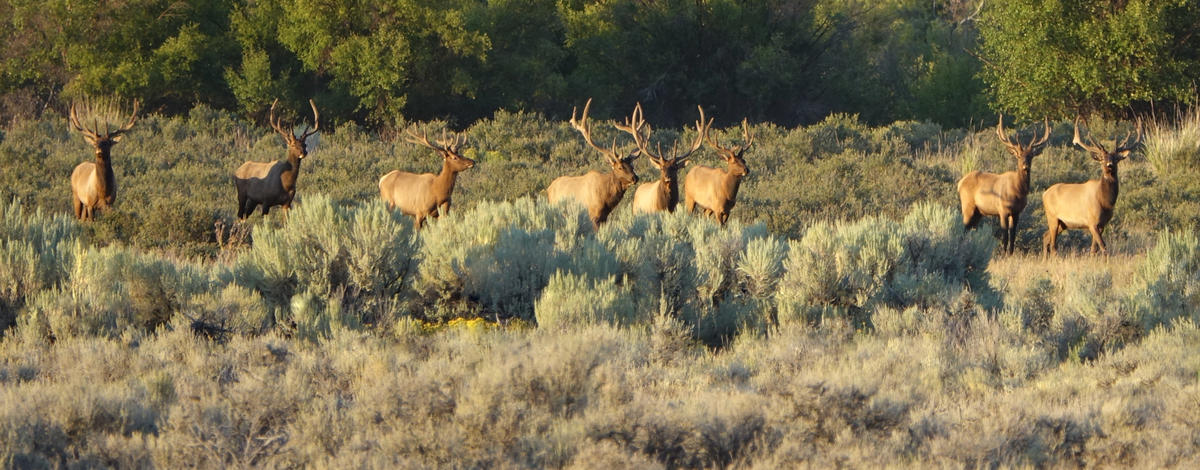Hunters can look forward to a good fall season in 2018, with similar elk and white-tailed deer populations as last year and likely more mule deer in many areas.
Despite a setback in 2017 following a hard winter that mostly affected mule deer, most of Idaho’s deer and elk herds and harvests have been at or near historic highs in recent years and well above long-term averages. Hunters should see similar numbers this fall.
Let’s look at some figures to back that up.
In 2017, hunters took 22,751 elk, and they have killed more than 20,000 elk annually since 2014. That’s a significant statistic because before 2014, elk harvests were well below 20,000 for seven years. (The 10-year average from 2008-17 is 18,865 elk).
The last extended streak of elk harvests above 20,000 was from 1988 to 1996, which were historic high harvests in Idaho that topped out at 28,000 in 1994.
Whitetails are on a similar trend. Hunters took 26,502 whitetails in 2017, another 26,354 in 2016 following an all-time record of 30,578 whitetails in 2015. The last four years have been the highest consecutive years on record.
But mule deer hunters have not been as fortunate. A combination of a tough winter in 2016-17 and cutbacks in antlerless tags to protect breeding age does dropped the harvest by nearly a third from 37,070 in 2016 to 25,496 last year, but hunters should expect to see a modest increase this fall.
Here’s a more detailed look.

Elk
Idaho elk hunters are having some of the best hunting of all time, and there’s no reason the current streak can’t eventually compete with all-time highs based on recent harvests and trends.
Word has gotten out that Idaho’s elk hunting is on an upswing, and part of the attraction is a combination of readily available tags sold over the counter and healthy elk populations. Elk tag sales have increased for the last five years and exceeded 100,000 annually since 2015. Prior to 2015, tag sales had not topped 100,000 in 16 years. Nonresident tags sold out in 2017, and they are selling faster this year, and will likely sell out again.
The 2017 elk harvest ranked second-highest in the last decade with 1,242 more elk than in 2016. It also ranks sixth all-time, and it’s 30 percent above the 50-year average elk harvest.
Here’s how the 2017 elk harvest breaks down:
- Total: 22,751
- Overall success rate: 24.4 percent
- Bulls: 11,650
- Cows: 11,101
- Elk taken during general hunts: 13,277 (18.4 success rate)
- Elk taken during controlled hunts: 9,473 (44.6 percent success rate)
Elk populations remain strong because they’re less susceptible to winter kill than deer, so they can continue to rebuild herds from year to year. Last winter, statewide calf survival was 66 percent, and the long term average 55 to 65 percent.
While Idaho is reliving some of its glory years for elk hunting, the location of the animals has changed. During record harvests in the 1990s, Central Idaho’s backcountry and wilderness areas were major contributors. They are less so these days, but other areas have picked up the slack.
There’s been a shift in populations from the wilderness and backcountry areas toward the interface between forest lands, agriculture and rural areas.
Harvest results show this. The Panhandle is currently the top elk zone in the state, and the top 10 zones include the Weiser River, Pioneer, Boise River, McCall, Smokey/Bennett and Salmon zones, all of which have major highways running through them.
Those top-producing zones provide accessible opportunities for many hunters, but also have unique challenges because there’s often a mix of public and private lands where the elk roam.
Elk herds are doing so well in some zones, such as the Weiser River and Pioneer zones, that those herds are over objectives and Fish and Game has increased cow hunting opportunities to thin the herds.
For new elk hunters, or experienced hunters looking for a new place to hunt, Idaho’s elk populations are likely to remain healthy in the foreseeable future, so now’s a good time to learn a zone where there are abundant herds.
Idaho offers a variety of over-the-counter tags for elk hunters. Out of 28 elk hunting zones, only two are limited to only controlled hunts, although many zones have limits on the number of tags available.
Hunters should research each zone and may want to look beyond the general, any-weapon seasons to find additional opportunity. Many archery and muzzleloader hunts provide antlerless, or either-sex hunting, and also options for early and late-season hunts.
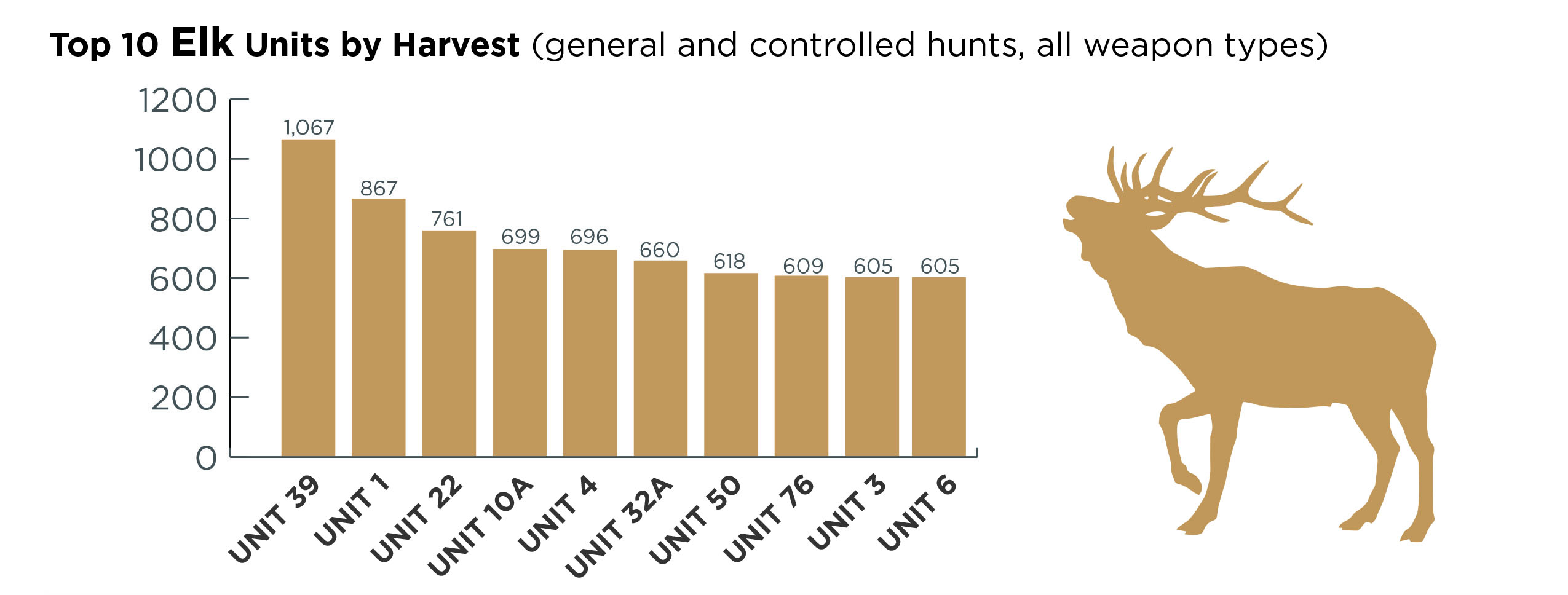
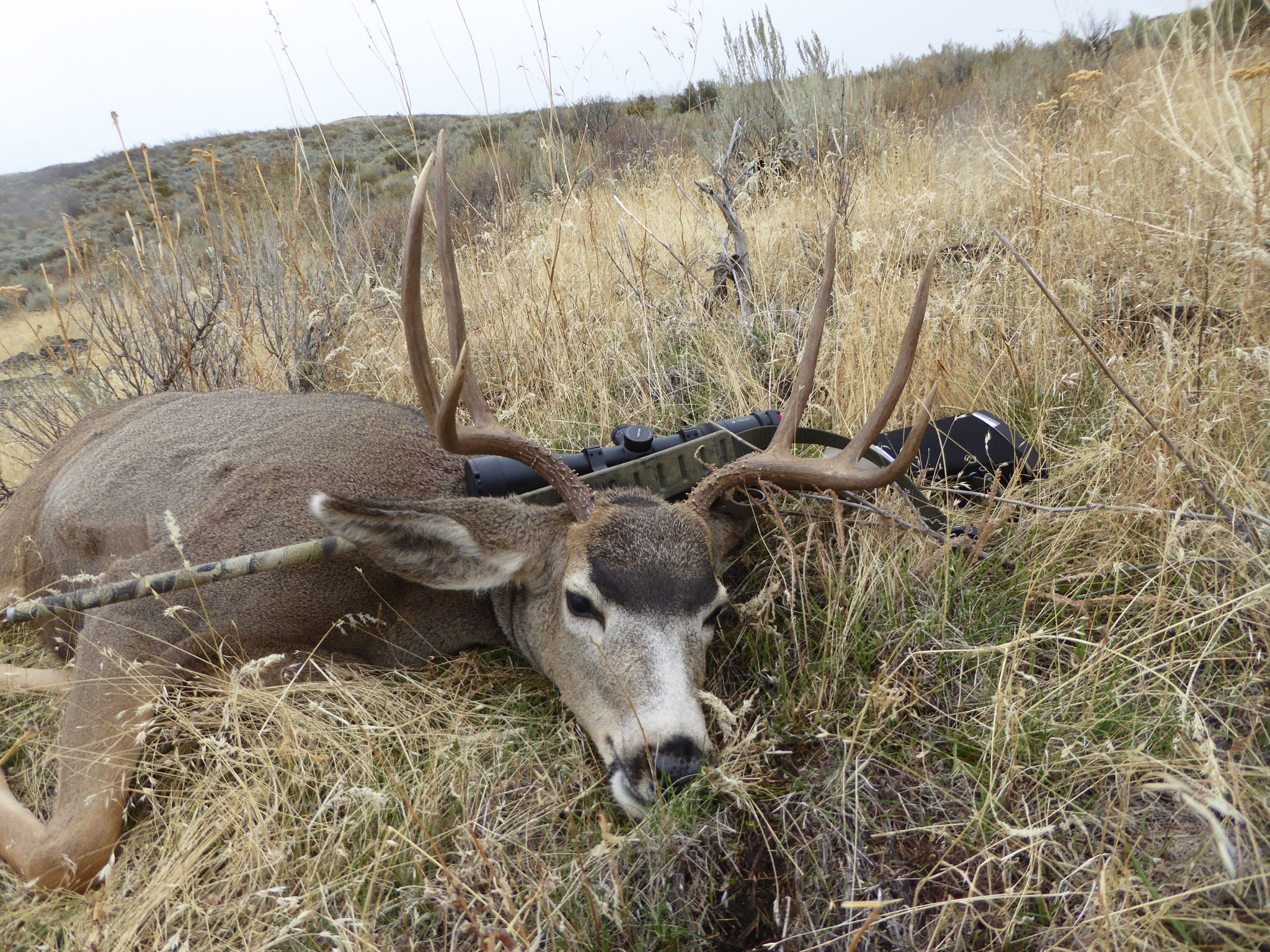
Mule deer
Mule deer hunting had also been on an upswing in recent years, but a tough winter across most of southern Idaho in 2016-17 winter dropped the population, which also contributed to a drop of 11,574 in the mule deer harvest between 2016 and 2017.
But a few things should be noted. The drop in doe harvest accounted for 22 percent of the difference between those two years, which was intentional to protect the does that will hopefully continue rebuilding the herds in coming years. Most of those protections remain in place.
Deer tag sales in 2017 fell by 7,323 tags compared with 2016. If those tags had been purchased, and those hunters matched the 2017 success rate for mule deer, it would have added another 2,123 deer to the harvest. That’s assuming they were all mule deer hunters because success rates for whitetails is significantly higher (see below for details about whitetails).
While the mule deer harvest dropped by 31 percent between 2016 and 2017, the success rate between the two years only dropped by 8 percentage points, 37 percent success in 2016 vs. 29 percent in 2017.
Here’s the breakdown of the 2017 mule deer harvest:
- Total: 25,946
- Overall success rate: 29 percent
- Bucks: 20,275
- Does: 5,221
- Mule deer taken during general hunts: 18,588 (24.5 percent success rate)
- Mule deer taken during controlled hunts: 6,909 (56.4 percent success rate)
Mule deer herds had been growing leading up to 2017 with five consecutive years of above-average winter fawn survival until the 2016-17 winter, which had only 30-percent fawn survival (based on radio-collared fawns) and was the second-lowest winter survival since fawn monitoring started in 1998.
Fawn survival vastly improved this year. The 2017-18 winter survival nearly doubled from the previous winter’s 30 percent survival to 57 percent last winter, which is right at the long-term average and should mean more young bucks in the herds during fall.
That’s the age group that saw a sharp drop in the harvest, accounting for 10,171 mule deer in 2016, but only 6,462 in the 2017 harvest.
Mule deer fawn survival rates last winter were also unusually uniform in the seven monitoring areas spread across the state with the lowest coming in at 45 percent and the highest at 66 percent.
Returning to an average fawn survival rate could easily bump the 2018 harvest by several thousand young bucks, however, there will still be fewer 2.5-year old bucks, many of which perished in the 2016-17 winter or were taken by hunters in 2017.
The Southeast Region and the McCall/Weiser areas were hardest hit during the severe 2016-17 winter, while other areas had closer-to-normal fawn survival, but still below average. Areas that weren’t hit as hard are likely to recover more quickly.

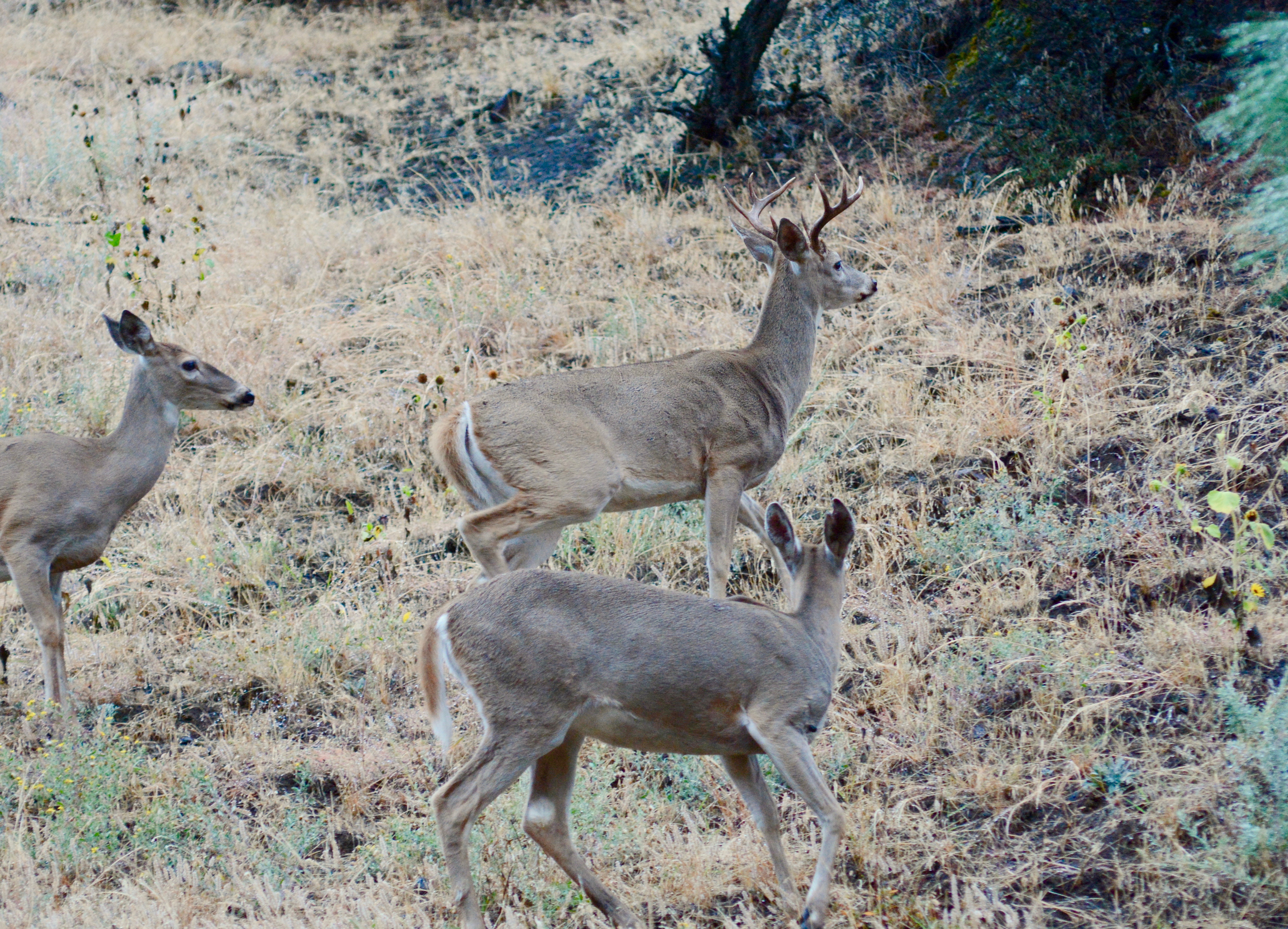
White-tailed deer
Whitetails have long-been a favorite quarry for hunters in the Panhandle and Clearwater regions, where they account for the vast majority of the harvest. But whitetails have also taken on statewide significance in recent years because their harvest has increased and closely matched mule deer, which has traditionally far outnumbered whitetails in the harvest.
Part of the reason for the shift is stable and abundant whitetail herds, lots of general season hunting opportunities that include long seasons and liberal regulations with either-sex hunting. Those factors also contribute to a higher success rate than mule deer.
Let’s breakdown the 2017 whitetail harvest:
- Total: 26,502
- Success rate: 43.9 percent
- Bucks: 15,895
- Does: 10,607
- Bucks five points or larger (on one antler): 3,384
- General season harvest: 23,312 (42.7 percent success rate)
- Controlled hunt harvest: 3,189 (54.6 percent success rate)
Unlike mule deer, Fish and Game does not radio collar whitetail fawns and does each winter and monitor their survival, or do other annual population surveys for whitetails. Biologists rely on other data to judge the health of the population, including harvest data.
Harvest has been over 26,000 for the last four years, and the number of five-points in the harvest has been consistent since 2007.
Whitetail hunting is meeting nearly all of the department’s objectives for the number of hunters, hunter days, buck harvest, and percentage of five points. The only exceptions are the Selway/Middle Fork areas are below objectives for hunt numbers and days, and southern Idaho is below objective for five-points, but southern Idaho is not considered a major focus for whitetail hunters.
Idaho has not seen any significant outbreaks of whitetail diseases in recent years, and no outbreaks have been detected this year.
All signs point to another good year for whitetail hunters with lots of opportunity and the chance to get a bigger buck for those who put in the time and effort.
Whitetail hunters should be aware of rule changes in Unit 10A in 2018, which includes a shortened season (Oct. 10 through Nov. 20), and hunters can not use a second deer tag in that unit.
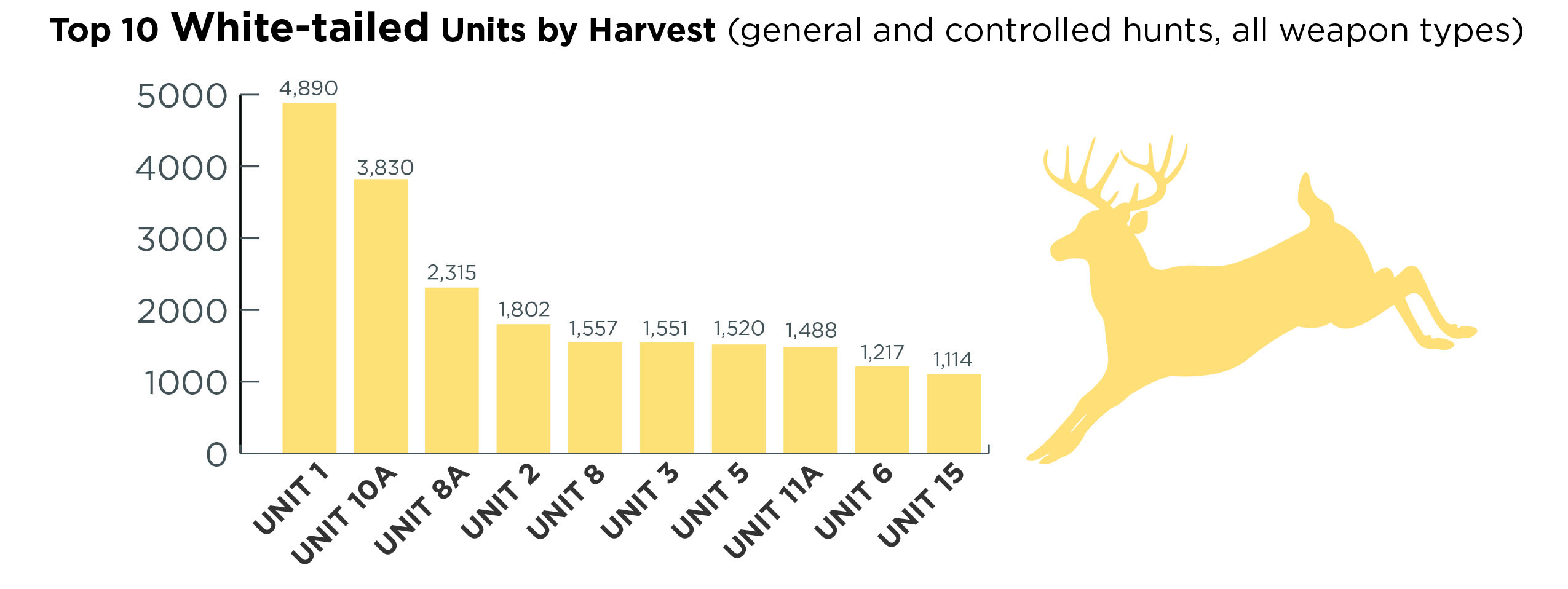
To learn more about harvest statistics, places to hunt, rules and more information, see the Hunt Planner.
Regional deer and elk reports
Panhandle Region
Panhandle had mild to normal winter conditions from 2012-2016, which tends to mean higher deer and elk survival and good hunting conditions. The winter of 2016-17 was a long, snowy winter with lower elk calf survival. Even so, the Panhandle had its highest elk harvest last year, partly attributed to the addition of antlerless hunting opportunities during the general season.
Last winter (2017-18) wasn’t as snowy, but it started early and ended with a long, wet spring. Surprisingly, we had our lowest elk calf survival since we started radio-collaring calves four years ago in Units 4, 6, and 7. During mild winters, calf survival was about 80 percent compared to the last couple hard winters when survival was about 40-50 percent.
The good news is that adult elk have high survival (94 percent) regardless of winter conditions and mature bulls will be roaming the woods this fall. We may, however, see fewer spike bulls in the harvest this year in some areas.
Elk and deer residing in valley locations have higher survival due to lower snow depths, better forage, fewer predators and less hunting pressure. This is why we are able to offer more antlerless hunting opportunities in the lower elevation, predominantly private land areas.
We believe deer hunting will be good again region wide, especially for white-tailed deer. Fall of 2017, we harvested over 11,000 deer, the fourth-highest harvest in the last ten years. Early reports of fawn sightings are especially encouraging and should bode well for this season and hopefully for next year as well.
One great thing about the Panhandle is that in addition to all the public land we have, there is a lot of corporate timber land. While a few may charge an access fee, most of them allow public hunting at no charge. You just need to be aware that it still is private land and treat it with respect. Because it is more intensively managed than public land, it often offers great forage and hiding cover a few years after timber harvest and supports ample deer and elk populations. You don’t want to pass these areas up.
Weather conditions during the hunting season affect big game behavior and distribution. Hot, dry weather can result in game using green agriculture fields or thick, timbered areas. Rain can improve availability of quality, native forage, which can lead to big game being more widely dispersed on the landscape.
Doing some scouting of potential hunting areas may give hunters an idea of animal distribution and behavior. Hunters can also use preseason scouting to check road and trail accessibility and conditions, as well as make landowner contacts if they are planning to hunt on or near private property. Check for potential fire closures before you head out to your favorite hunting spot. In late August, there were fire closures in parts of Units 1 and 4. You can get current information on Fish and Game's Fire Information page.
Clearwater Region
Winter conditions in the Clearwater region came early with snows starting in early October. However, temperatures warmed up, melting snow and giving way to mostly mild conditions. These conditions caused the Clearwater region to cancel their annual aerial elk survey due to the lack of snow.
Later, we saw winter conditions return with colder temperatures and deep snow. Despite the unusual weather conditions, the small number of elk and deer we have collared faired well and we saw calf survival around 70 percent, cow survival around 97 percent, and white-tailed deer survival around 90 percent.
This is typical of what we have seen the past few years. Every year we have some pockets where we lose a few deer and elk, but we didn’t receive reports that indicated this winter was any different. The region saw a cool and wet spring creating good forage and habitat conditions for deer and elk.
Although the summer has been hot and dry, we have not had reports of suspected EHD/blue tongue (diseases that kill deer) in our area. While it is still possible to see an outbreak, we are past the critical period.
Currently, we have some large wildfires burning in our region that may affect hunters. However, we advise all hunters to keep an eye on fire conditions, closures, and warnings.
Deer hunters intending to hunt Unit 10A should be aware of the season changes in that unit. A second non-resident deer tag cannot be used in Unit 10A. In addition, season dates were shortened to Oct. 10 through Nov. 20 for white-tailed deer tag holders. However, regular deer tag holders can still only hunt Oct. 10-Nov. 3.
Overall, conditions should offer another productive hunting season, and we expect to see similar numbers of deer and elk. However, during hunting season, success and harvest is more of a reflection of the current weather conditions and less about herd numbers. If it’s hot and dry hunting can be more difficult but if temperatures are cooler and we get precipitation hunters tend to be more successful.
Southwest Region
Things started out very mild last winter with high deer and elk survival, but started to dip in mid-late February when winter became colder and snowier. Overall, we still had good deer and elk production and survival throughout the southern part of the region.
While the winter of 2016/17 had some effect, it hit deer fawns and elk calves the hardest, particularly in Units 33, 34, and 35. The good news is that adult doe and cow survival was high throughout the subregion that winter, meaning adult females were still around to produce robust fawn and calf crops this year.
Boise River Deer
Overwinter fawn survival for the 36 collared fawns in Unit 39 was 61 percent in 2018. The fawn:doe ratio in December was 84:100, which works out to 51 fawns recruited for every 100 does. This is more fawns than entered the winter of 2016-2017 Doe survival greater than 88 percent generally means stable-to-increasing population.
Most of the bucks taken during the general deer season are typically yearlings (two-points and spikes) and this year looks to be good for yearlings.
A full sightability survey was conducted in late January-mid-February 2018. Total population estimate was about 28,000 deer. That’s an increase of 5,000 deer over the 2010 estimated population of about 23,000 deer.
Central Mountains Deer (South Fork of the Payette River only)
Overwinter fawn survival for five fawns captured along the South Fork of the Payette River was 80 percent. December Fawn:doe ratio was 43:100, which means 34 fawns were recruited for every 100 does. (Please note small sample size of fawns). Doe survival was 100 percent.
Boise River Elk
Overwinter survival for 19 collared calves in Unit 39 was 84 percent. Cow survival was 97 percent. Elk numbers have been steadily increasing in this zone and the mild winter of 2017/18 combined with robust calf production certainly added to the numbers.
Sawtooth Elk
Overwinter calf survival for 27 collared calves in Units 33 and 35 was 81percent. Calf:cow ratio in January was 36:100, which means 29 calves were recruited for every 100 cows. Cow survival was 98 percent.
Elk numbers in the Sawtooth Zone continue to increase gradually. Numbers are still below management objective, but good calf production and mild winter conditions like we have had this year will help the population grow. Hunter opportunity for antlerless elk is very limited, but bull elk hunters have been having very high success rates for the past few years with both the A and B tags.
Owyhee Deer
Data on mule deer in the Owyhees is limited, but population trends generally follow that of the Boise River Zone. With mild winter conditions last year and good fawn recruitment and adult overwinter survival in nearby areas, we expect deer numbers to be up in the Owyhees from last year.
McCall Subregion
Winter survival was average (60 percent) for fawns in the Weiser-McCall area, which includes deer in Units 31, 22, 32, 32A, 23 and 24. Survival was around average (94 percent) in those same units for does.
Annual deer herd composition flights found healthy fawn:doe ratios in Weiser units, but lower than usual buck:doe ratios, likely due to the hard winter of 2016-2017.
No elk calves were collared, but survival for cow elk in Weiser units was very high – near 100 percent. This year, the cap was removed from the Weiser A tag, so it may be pretty busy because of that, particularly during the cow hunt (Oct. 10-24).
Fires updates
There are significant closures in late August on the Payette National Forest near the Mesa Fire (Unit 32) and the Rattlesnake Fire (Unit 22). Both fires are nearing full containment, so hunters should watch for possible changes to those closures prior to hunting season. You can get current information on Fish and Game's Fire Information page.
Pioneer Fire
The Pioneer Fire of 2016 burned in both the Boise River Zone and the Sawtooth Zone and hunters may still be affected. The fire likely pushed big game out of that area for some time, but the area has likely recovered to the point that deer and elk are moving back in. Big game forage should be excellent. Hunters are advised to check with the Boise National Forest on potential road closures and area closures in and around the Pioneer Fire.
Magic Valley Region
Mule deer populations in the Magic Valley Region are generally increasing at a slow rate. A combination of mild winters and good habitat conditions has resulted in average to above-average fawn production and survival over the last five years.
In 2017-18 fawn survival in the Smoky-Bennett area (Units 43, 44, 45, 48, 52) was slightly above normal at 66 percent. Recent fawn survival estimates in the South Hills have been average to above-average. While we did experience localized reductions in mule deer numbers in the northeastern portion of the region (primarily Unit 49) in 2017, these herds appear to be slowly rebounding.
In 2018, department biologists surveyed the Bennett Mountain winter range, which supports deer from Units 39, 43, 44, 45, 48, and 52. The 2018 population estimate was 16,358, 19 percent higher than our previous estimate in 2012.
Hot and dry summer conditions, combined with recent wildfire activity throughout the region has affected mule deer distribution. Mule deer are likely going to be found in larger groups near water and green vegetation, on public lands near the irrigated agriculture interface, or at higher elevations where better vegetation conditions persist. Late summer or fall precipitation could result in green up, which will helps disperse deer.
Elk numbers in the Magic Valley Region remain strong with all elk zones at-or-above harvest and population management objectives. Overwinter calf survival for radio-collared calves in Unit 45 was over 90 percent while cow survival exceeded 97 percent in the Smoky-Bennett and Pioneer zones.
Like mule deer, hot and dry summer conditions and recent wildfire activity in the region has affected elk distribution. Elk are congregating in larger groups and if conditions persist, will be found in proximity to perennial water sources and associated green vegetation, near the irrigated agriculture interface, and at higher elevations with cooler temperatures and higher quality vegetation resources.
Recent wildfires in the region had generally subsided by late August. All access restrictions associated with the Sharps Fire in Unit 49 have been lifted by the Forest Service and BLM. One fire in western Camas County (Stewart Creek Fire) may affect access to Forest Service land in the northwestern portion of Unit 44 and a small part of Unit 43 (Middle Fork Lime Creek and Iron Mountain areas). Hunters should check for updates on fire status and any access restrictions prior to hunting season.
Southeast Region
The winters from 2012-16 were relatively mild to average -- good news for big game populations and hunters alike. Elk and mule deer numbers were doing well, and hunters reported some of the best success rates southeast Idaho had seen in a while.
However, the winter of 2016-17 was extremely severe, and big game populations experienced higher than normal mortality. Thankfully, the winter of 2018 was generally mild throughout the region, offering big game animals, especially mule deer, some reprieve—but this isn’t enough for a full rebound.
Mule deer hunting will be similar to what was experienced in Fall 2017 with one exception: hunters should see more yearling (2-point) bucks on the landscape this year.
In the first year following a harsh winter, biologists don’t expect the mule deer population to grow substantially. Females that survived the winter are typically in poor body condition resulting in lower reproductive rates and survival the subsequent year. Still, range conditions have been good, and if the 2018-2019 winter is again mild we expect to see a much larger increase in the deer population by Fall 2019.
Hunters should also be aware that in response to the severe winter of 2016-2017, the Southeast Region Game Management Units are once again closed to youth-only antlerless hunting to protect does and to maximize fawn production. This includes Units 66A, 70, 71, 72, 73, 73A, 74, 75, 76, 77, and 78.
Elk are more resilient to harsh winter conditions than deer are. Elk are doing well across the region as evidenced in aerial surveys conducted this past winter. Hunters should expect good elk hunting opportunity this fall.
Last winter, the Southeast Region monitored 63 GPS-collared mule deer does in the Bannock and Caribou Population Management Units (PMUs). Survival on these marked mule deer was 94 percent.
The Southeast Region also monitored 65 cow and 28 calf elk with GPS collars in the Diamond Creek elk zone. Cow survival was 95 percent while calf survival was 75 percent. High survival of deer and elk should be encouraging for hunters this fall.
Fish and Game conducted an aerial survey in 2015 to determine deer population estimates for the Bannock PMU. On average, each game management unit in the southeast region had about 3,000 mule deer during the February time frame, with the exception of Unit 73, which had a population estimate of nearly 8,000 deer. In 2013, Fish and Game conducted an aerial survey of the Caribou PMU and found an estimated 4,000 and 7,400 deer in Units 72 and 76, respectively.
It is important to remember these population estimates represent deer counted on winter ranges. In some cases, the game units in which deer winter are not the same as those used during the summer and fall. Additionally, this survey occurred prior to the 2017 winter where deer survival was low. Current population levels are likely below what was surveyed in 2015.
The Diamond Creek elk zone is a premier archery hunt and a sought-after, controlled any-weapon hunt. The archery hunt is capped at 1,836 tags and sells out earlier and earlier each year. This year, all resident tags were sold on the first day they were available.
An aerial survey was conducted in this zone in 2018 and the population estimate was 5,052 elk. This was a dramatic increase from the previous survey in 2013 when the population estimate was 2,300 elk. The bull:cow:calf ratio was 36:100:36.
The aerial survey is conducted in January, so is a winter population estimate. We know from GPS data that some elk that summer in the Diamond Creek zone winter in other locations, such as the Tex Creek Zone, therefore we know the number of elk in the Diamond Creek zone during the hunting season is higher than during the winter survey.
The Bear River elk zone includes units 75, 77, and 78. This is another elk zone for which Fish and Game conducts aerial surveys and it was last flown in 2017. The 2017 winter survey found an estimated 1,257 elk using the zone; this represented an almost 40 percent increase from the previous survey conducted in 2010.
As with the Diamond Creek Zone it appears that some elk summering in Bear River Zone move into Utah to winter, so we expect the number of elk in this zone during the hunting season is likely higher than during the winter survey.
Things to Consider Before the Hunt
Weather conditions during the hunting season affect big game behavior and distribution. Hot, dry weather can result in game using green agriculture fields or high elevations and timbered areas. Rain can improve availability of quality native forage and natural water sources, which can lead to big game being more widely dispersed on the landscape.
Doing some scouting of potential hunting areas may give hunters an idea of animal distribution and behavior. Hunters can also use preseason scouting to check road and trail accessibility and conditions as well as make landowner contacts if they are planning to hunt on or near private property.
Upper Snake Region
Mule deer populations increased across the Upper Snake Region from 2012-2016 because of good summer precipitation and mild winters. Mule deer populations decreased significantly in 2017 following a severe winter and hunter harvest decreased accordingly.
Generally speaking most of the losses were the 2016 fawn age class, which would have been 2.5 year olds this fall. Fawn-to-doe ratios observed last winter were low-to-average depending on the area. The survival rate of those fawns was average, about 50-60 percent. This information indicates that although mule deer populations are increasing across the region, they are increasing slowly. The number of yearling bucks this fall will certainly be much higher than last year.
Elk populations continue to do well in the Upper Snake Region with all zones within population objectives. Last winter, biologists completed population surveys in the Lemhi zone and the Tex Creek zone. Those surveys indicated that both of those populations had grown since the last surveys were conducted. The estimated number of elk in the Lemhi zone is 5,193 which is slightly higher than the 2011 estimate of 4,964. The 2018 population estimate for the Tex Creek zone is 5,495 elk, significantly higher than the 2013 estimate of 3,885.
Salmon Region
Mule deer populations increased across the Salmon Region from 2012-2016 due to favorable summer and winter conditions, then populations decreased significantly in 2017 following a severe winter. Most of the 2016-17 losses were fawns, and these deer will be 2.5 years old this hunting season, which will be smaller portion of the population than in the past.
Fawn-to-doe ratios observed last winter were low-to-average across the Salmon Region, and the survival rate of those fawns was average, around 50 to 60 percent. This suggests mule deer populations are increasing slowly across the Salmon Region, and hunters will find yearling bucks more plentiful than last year.
Elk populations continue to do well in the Salmon Region and elk hunting will be good, with little change from last year.
Elk Zones east of U.S. 93 (Beaverhead, Lemhi, Pioneer) are at or above elk plan objectives, and zones west of U.S. 93 (Salmon, Middle Fork) are at or slightly below objectives.
Last winter, biologists completed a population survey in the Lemhi Zone, which indicated the population is within elk plan objectives and performing well under current management.

